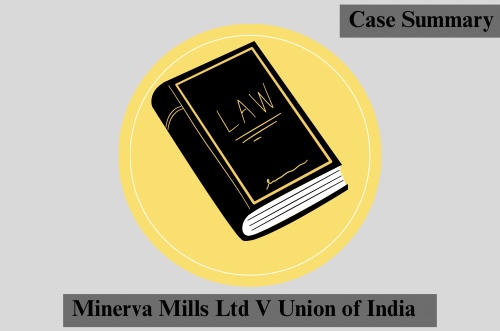
Read Time:3 Minute, 26 Second
Minerva Mills Ltd V UOI
AIR 1980 SC 1789 : (1980) 3 SCC 625 : (1980) 1 SCR 206 : (1980) 1 SCJ 344
Brief of the Case
Brief
Citation : AIR 1980 SC 1789 : (1980) 3 SCC 625 : (1980) 1 SCR 206 : (1980) 1 SCJ 344
Court : The Supreme Court of India
Date of Decision : 31 July 1980
Judges : YV Chandrachud CJ, NL Untwalia, AC Gupta, PS Kailasam and PN Bhagwati, JJ
Petitioner : Minerva Mills
Respondent : Union of India
Facts of the Case
Facts
- In this very case a petition arose out of the takeover by the Central Government of the management of the mill under the Sick Textile Undertakings (Nationalisation) Act, 1974. The said Act had been included in the 9th Schedule by the virtue of Entry 105, thus preventing any petition which may challenge the impugned Act.
- Minerva Mills challenged the Constitutional validity of the 39th Amendment and the 42nd Amendment. Minerva Mills also challenged the validity of clauses (4) and (5) of Article 368 and Section 55 of the 42nd Amendment.
Issue of the Case
Issue
- In this case the issue which arose was related to the Constitutional Validity of Section 4 and Section 55 of the 42nd Constitutional Amendment Act of 1976 which effected changes in Article 31C and 368.
Judgement of the Case
Judgement
- The Section 4 of the Constitutions 42nd Amendment Act is beyond the amending power of the Parliament and is void in nature as it damages the basic or essential features of the Constitution and destroys its basic structure by a total exclusion of challenge to any law on the ground that it is inconsistent or takes away or abridges any of the rights conferred by Article 14 or Article 19.
- If the law is for giving effect to the policy of the State towards securing all or any of the principles laid down in the Part IV of the Constitution. Section 55 of the Constitutions 42nd Amendment Act is also beyond the amending power of the Parliament and is void since it removed all limitations on the power of the Parliament to amend the Constitution and confers power upon it to amend the Constitution so as to damage or destroy its basic or essential features.
- Article 31C (amended) is unconstitutional since it destroys the Basic Features of the Constitution by totally excluding from challenging any law giving effect to the Directive Principles. Even if they are inconsistent with the rights under Article 14 and Article 19. The Indian Constitution is founded on the bedrock of the balance between Part III and Part IV.
- To give absolute supremacy or primacy to one over the other is to disturb the harmony of the Constitution. The harmony and balance between the two is an essential feature or the basic structure of the Constitution of India. The goal set out in the Part IV has to be achieved without abrogating the means provided for by Part III. They are meant to supplement each other.
- Clause 4 and Clause 5 of Article 368 are also unconstitutional in that they removed all limitations on the amending power of the Parliament and thereby conferred an unlimited amending power which is destructive of the basic feature of the Constitution. It is the Constitution which is Supreme in India and not the Parliament.
- The Parliament is the creature of the Constitution and derives its power from the Constitution including the power to amend under Article 368. There is a clear distinction between ordinary legislative power and the constituent power. Hence, the amending power cannot be exercised by the Parliament in such a way as to subvert or abrogate the Constitution.
Held
Held
- It was held that Section 4 and Section 55 of the Constitutions 42nd Amendment Act are unconstitutional and void. Article 31C (amended), Clause (4) and Clause (5) of Article 368 are unconstitutional and void.







